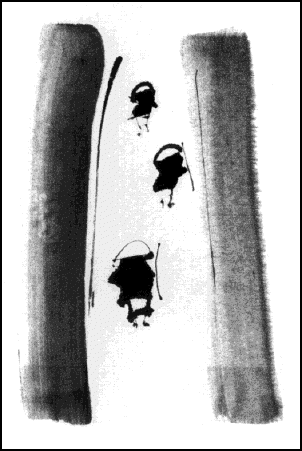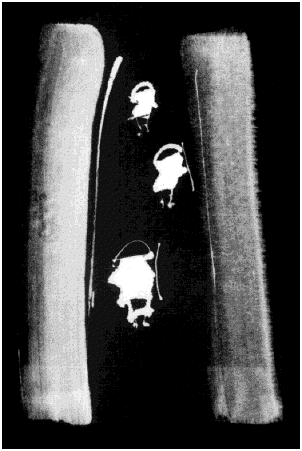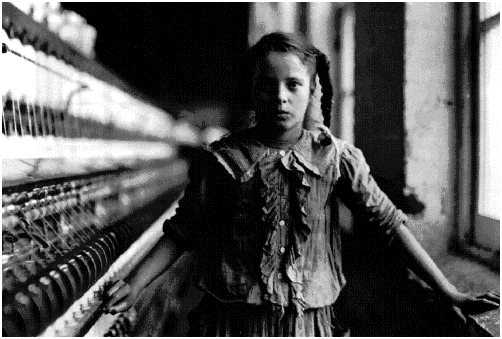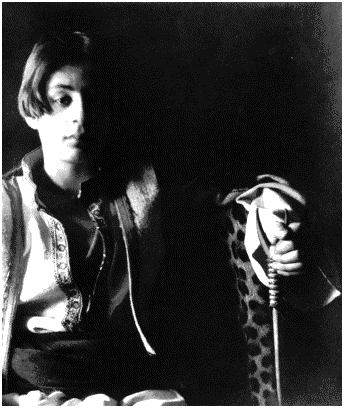Journey
Basho's
Narrow Road to
A Far Province
Dorothy Britton,
Translator
(Kodansha International)*

This trip was no picnic. The two poets were over forty years old; Basho had problems with his lungs; and the entire trip was to encompass almost 1000 miles. There were no trekkers signs, no Youth Hostels, no Howard Johnsons, or, in some cases, not even roads to follow.
But, they were poets --- and Buddhist monks --- with a mission, and they covered many miles before Sora gave up (Basho went on alone). They stayed in fisherman's huts, dressed simply, taking notes in verse. They littered their way with haiku, commentary on what they had seen, tributes to earlier poets, reflections on their surroundings.
These poems are here neatly sandwiched between the narratives of their journey, and --- as is true of all good poets --- the prose is poetic. These are the opening lines to "Narrow Road to a Far Province:"
The passing days and months are eternal travellers in time. The years that come and go are travellers too. Life itself is a journey; and as for those who spend their days upon the waters in ships and those who grow old leading horses, their very home is the open road. And some poets of old there were who died while travelling.
Basho attributes his arduous journey to wanderlust inspired by the wind, "the road gods," and the "god of temptation."
So I mended my breeches, put new cords on my hat, and as I burned moxa on my knees to make them strong, I was already dreaming of the moon over Matsushima.
I suppose this is heresy, but I found myself in thrall to Basho's prose --- and somewhat less enthralled by the haiku that he and Sora composed. I have no doubt that much of it is a problem of getting Japanese into English. I'm fond of the simplicity and economy of it; I'm cognizant --- due to the excellent introduction --- of Basho's revolutionary effect on haiku; but still, when faced with certain awkwardnesses, one can be less than overwhelmed by the poetry of it, or, more, caught up in the implicit comedy of certain words and images:
Loath to let spring go,
Birds cry, and even fishes'
Eyes are wet with tears.
Or,
Sadly, I part from you;
Like a clam torn from its shell,
I go, and autumn too.
 Fish, we suppose, could be thought of as having feelings (or, as the chanteuse Spivey used to sing it, "How would you like to sleep in the water you drink?") Parting is, of course, such sweet sorrow --- but must we think of it as a shucking? More successful are the patently comic verses. Since the accomodations were less than regal, one could sympathize with bugs and the making of much water:
Fish, we suppose, could be thought of as having feelings (or, as the chanteuse Spivey used to sing it, "How would you like to sleep in the water you drink?") Parting is, of course, such sweet sorrow --- but must we think of it as a shucking? More successful are the patently comic verses. Since the accomodations were less than regal, one could sympathize with bugs and the making of much water:
Fleas and lice did bite;
And I'd hear the horse pass water
Near my bed at night.
It's a leisurely and pleasant journey we get to go on with Basho --- reminding us of other poetic wanderings: Wordsworth, Coleridge and Southey in the Lake Country, Ginsburg and Kerouac and Corso back and forth between New York and San Francisco, the stoned ramblers of the 60s. Fortunately, the editor has chosen not to translate Basho's name into modern English (Basho means "Banana Leaf;" would you have bought a volume of haiku by Matsuo Banana-Leaf?) Withal, Kodansha has produced a book of sweet design. The original Sumi drawings by Shiro Tsujimura are a dream.
*Also listed on the title page as "Kodnsha International"
Children
American
Photographs
1890-1925
Introduction by
George Dimock
(Washington Art Museum/
University of Washington)

These photographs were brought together for the running exhibit "Child Labor and the Pictorialist Ideal." As George Dimock says in his introduction,
This exhibition brings together two very different kinds of photographs in order to make an argument about the history of children and childhood in the United States.
On the one hand there are the photographs of Lewis Hine. He was hired on in the early 1900s to photograph children as part of the labor force, especially children working at jobs that could be dangerous for life and limb. These photographs were commissioned by the National Child Labor Committee. They wanted to persuade "voters and legislators to outlaw the employment of children in the workplace."
These stark photographs show child labor at its most grisly. One is entitled, Luther Watson, of Corinth, Ky. 14 years old...right arm was cut off by a veneering saw in a box factory in Cincinnati, Ohio, Nov. 1907. (Or see Fig. 1 above --- a girl working as a "spinner at the Rhodes Manufacturing Company, in Lincolnton, North Carolina.")
In contrast, there are photographs by F. Holland Day which were taken at about the same time. These show young men and women in romantic poses, filled with soft light and high contrast. [Note one of Day's protégés, the very young Kahlil Gabran, below.]
Often, these young men and women appear in languorous, indolent poses, and they are not without overtones of a sensuality and --- in a couple of cases --- are shots that might be viewed as erogenous. There is, for instance, a lens-fogged, bare-assed lad in contemplative pose in the garden, labelled "The Marble Fawn." Another, in scanty briefs, is referred to as "Saint Sebastian." Without the arrows.
When I was a tad --- definitely not erogenous --- we had a bit of nonsense song that we would repeat over and over again, to wit:
Alexander was a swoose;
Not a swan and not a goose;
Not a swan, not a goose ---
Alexander was a swoose.This volume, as interesting as the photographs are, has a bit of the swoose about it. Children of the time were seen as miniature adults. They could be posed as models for Pre-Raphaelite style photography. At the same time, they could be forced to --- work in a spinning mill. Sticking examples of these two very divergent child roles in the same book gives little coherence to the whole. I can make a cookbook about hearty stews, and I can make a cookbook about frappé-style desserts --- but to bind them in the same cover says a great deal about my all-encompassing taste but little about my sense of discrimination and order.
--- Ignacio Schwartz
